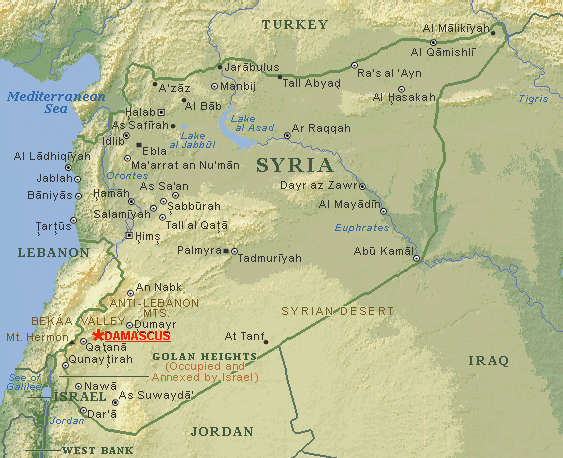Travels - > Middle East - > Syria & Lebanon - > Damascus
DAMASCUS
Damascus,
capital and chief city of Syria,
in southwestern Syria, on the Baradá River, near the Anti-Lebanon
Mountains in the southwestern part of the country. The greater part of
Damascus, including the rectangular ancient city, is on the south bank of the
Baradá modern suburbs extend from the north bank.
Damascus has long been an
important commercial center. In former times it was famous for dried fruit,
wine, wool, linens, and silks. Damask, a type of patterned fabric, was named for
the silk fabrics woven in Damascus. The city was notable also for the
manufacture and transshipment of damascened steel sword blades, which were
exceptionally hard and resilient. Today the city is the trading center for figs,
almonds, and other fruit produced in the surrounding region. Industries in
Damascus include handicrafts, such as the weaving of silk cloth and the making
of leather goods, filigreed gold and silver objects, and inlaid wooden, copper,
and brass articles. Among the city's other manufactures are processed food,
clothing, and printed material.
The streets of the city, with
the exception of the “street called Straight” (mentioned in the Bible in
Acts 9:11), on which Saint
Paul is supposed to have lived, are crooked and narrow. The houses
frequently combine a splendidly decorated interior with a plain and somber
exterior. The walls fronting the street are usually without windows.
Damascus has more than 200
mosques, of which 70 are still in use. Of these, the Umayyad Mosque, or Great
Mosque, is the most important. Said to have been a heathen temple, it was
converted into a Christian church at the end of the 4th century. It then
contained what was believed to be the head of Saint
John the Baptist and was named the Cathedral of Saint John. Other noteworthy
mosques are the Sinani-yah, with a striking green-tiled tower, and the Tekkeyah,
which was founded in 1516 on the riverbank west of the city as a refuge for poor
pilgrims. The National Library, the National Museum, and the University of
Damascus (1923) are in the city.
